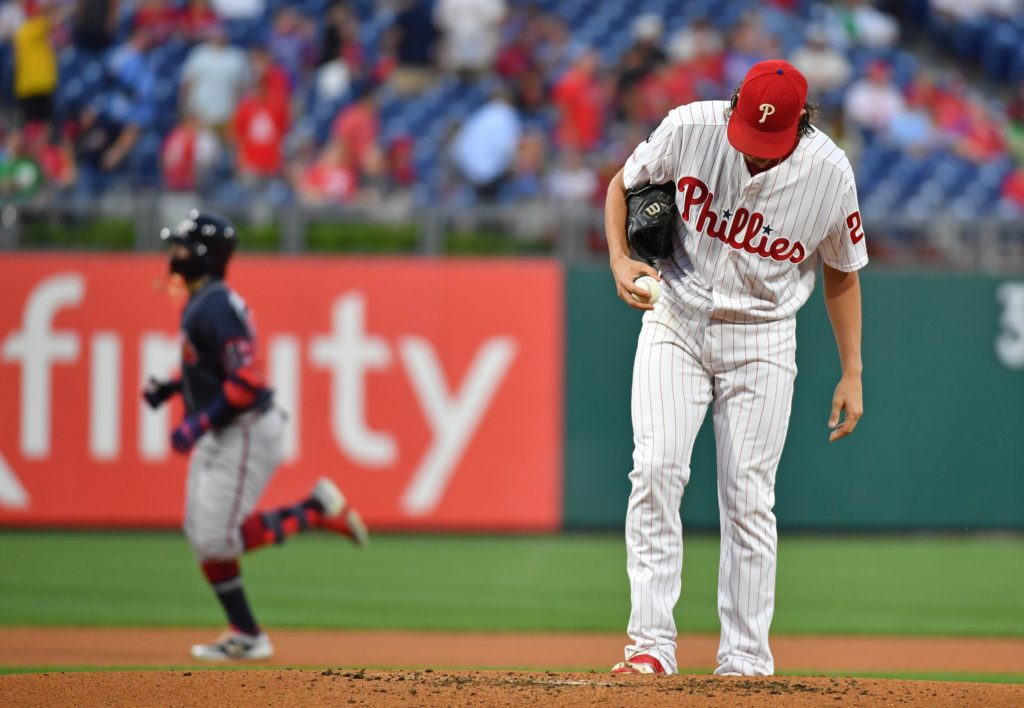Ad Disclosure
Aaron Nola’s Latest Rough Outing Raises More Questions for Phillies
By Bob Wankel
Published:

The last thing the Phillies need heading into an offseason loaded with pressing questions is one more bit of uncertainty, but it seems like that’s the way things are trending after another dud of a performance from Aaron Nola last night.
Under the microscope of a playoff race – if you want to call this a playoff race – narratives are susceptible to overreaction. As frustration or satisfaction intensifies, the takes get hotter, and thus it becomes easier to get carried away.
For instance, doubting Nola’s ability or overall worth would be foolish. That’s not what this is about because anyway you dice it, he’s been one of the National League’s best starting pitchers dating back to the start of last season.
But after another disappointing evening in which Nola again buried his team in an early multi-run deficit, I do think it’s fair to wonder where exactly he fits into a hypothetical playoff rotation when the Phillies officially turn the page to the 2020 season.
More specifically, is he good enough to headline one?
I think so. Maybe. Right?
This is the time of year that you want to see your best pitcher rise to the occasion, and to borrow a tired cliché, put the team on his back.
That hasn’t happened. In fact, quite the opposite has happened:
“uNSuSTAiNAbLE” pic.twitter.com/6NZlF0dSbv
— Bally Sports South (@BallySportsSO) September 9, 2019
Set the short-term frustration and consequences of these losses aside for a moment. What’s most important isn’t that a fatally-flawed team won’t get to hang on the periphery of a playoff race in late September, it’s what these losses may mean beyond this season.
Back on August 25, the offense failed for five innings to plate a run against Marlins starter Elieser Rodriguez. It finally broke through in the sixth inning when Rhys Hoskins gave the Phillies a 2-0 lead with a clutch two-run homer. Nola, however, promptly surrendered the lead in the bottom of the frame by allowing four straight hitters to reach base.
Did the offense fail him? Yes. Generally speaking, did he turn in a good start? Yes. Did he come up small in a big spot late against an inept offense in a game that would’ve saved the team the embarrassment of another series loss to a division punching bag? Also yes.
All three statements can be true.
Fast-forward to his next start on Aug. 30 against the Mets, when the offense yet again did him no favors until the fifth inning when it finally broke a scoreless tie. He carried a 1-0 lead into the seventh inning before a walk and hit batter set up a game-tying RBI single by Wilson Ramos.
Once again, Nola turned in a good start for the Phillies, but failed to finish in a tight spot.
I was a bit more forgiving after that game because, again, I think the nature of the situation tends to needlessly intensify the desire to blame in the moment, but he then followed those two disappointing finishes with back-to-back September clunkers against the Reds and Braves that looked like anything other than the work of an ace.
Is he tired? Maybe.
Over his last four starts, Nola has compiled a 5.01 ERA and 1.29 WHIP, walking 3.9 batters per nine innings. In 16 previous starts dating back to May 29, Nola pitched to a 2.95 ERA and 1.06 WHIP, walking 3.1 batters per nine innings.
Go back to last September when Nola had a 3.72 ERA and allowed opposing hitters to post a .729 OPS. Certainly, these aren’t egregiously poor numbers, but they were his worst of an otherwise sterling season.
It’s far more likely that fatigue is plaguing him than an inability to handle the moment or deal with pressure, but it doesn’t change the reality that his recent struggles are a concern.
Forget 2019, what happens if Nola makes 30 starts on a playoff team, and then he’s asked to take the ball twice in a five-game series? Can he be the guy to handle that task? That’s what the Phillies must decide.
What the team has long known, at least I suspect they do (they better), is that they can’t bank on this same cast of starters coming back next year and having success. They need to upgrade, but does that upgrade come in the form of one or two reliable mid-tier arms that supplement Nola, or does it come in the form of a piece that allows Nola to become an elite complementary piece?
Ultimately, we won’t know how he handles October baseball until this team actually gets there, but in the midst of his recent uneven performances, the presumption that he will dominate the moment when they finally do must at the very least be questioned.
More questions. Just what the Phillies needed.
Bob Wankel covers the Phillies for Crossing Broad. He is also the Vice President of Sports Betting Content at SportRadar. On Twitter: @Bob_Wankel E-mail: b.wankel@sportradar.com